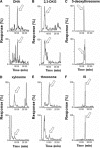Vitamin C degradation products and pathways in the human lens
- PMID: 21885436
- PMCID: PMC3199460
- DOI: 10.1074/jbc.M111.245100
Vitamin C degradation products and pathways in the human lens
Abstract
Vitamin C and its degradation products participate in chemical modifications of proteins in vivo through non-enzymatic glycation (Maillard reaction) and formation of different products called advanced glycation end products. Vitamin C levels are particularly high in selected tissues, such as lens, brain and adrenal gland, and its degradation products can inflict substantial protein damage via formation of advanced glycation end products. However, the pathways of in vivo vitamin C degradation are poorly understood. Here we have determined the levels of vitamin C oxidation and degradation products dehydroascorbic acid, 2,3-diketogulonic acid, 3-deoxythreosone, xylosone, and threosone in the human lens using o-phenylenediamine to trap both free and protein-bound adducts. In the protein-free fraction and water-soluble proteins (WSP), all five listed degradation products were identified. Dehydroascorbic acid, 2,3-diketogulonic acid, and 3-deoxythreosone were the major products in the protein-free fraction, whereas in the WSP, 3-deoxythreosone was the most abundant measured dicarbonyl. In addition, 3-deoxythreosone in WSP showed positive linear correlation with age (p < 0.05). In water-insoluble proteins, only 3-deoxythreosone and threosone were detected, whereby the level of 3-deoxythreosone was ∼20 times higher than the level of threosone. The identification of 3-deoxythreosone as the major degradation product bound to human lens proteins provides in vivo evidence for the non-oxidative pathway of dehydroascorbate degradation into erythrulose as a major pathway for vitamin C degradation in vivo.
Figures







Similar articles
-
Extending the spectrum of α-dicarbonyl compounds in vivo.J Biol Chem. 2014 Oct 10;289(41):28676-88. doi: 10.1074/jbc.M114.563593. Epub 2014 Aug 27. J Biol Chem. 2014. PMID: 25164824 Free PMC article.
-
Identification of Kynoxazine, a Novel Fluorescent Product of the Reaction between 3-Hydroxykynurenine and Erythrulose in the Human Lens, and Its Role in Protein Modification.J Biol Chem. 2016 Apr 29;291(18):9596-609. doi: 10.1074/jbc.M116.716621. Epub 2016 Mar 3. J Biol Chem. 2016. PMID: 26941078 Free PMC article.
-
The effect of UVA light on the anaerobic oxidation of ascorbic acid and the glycation of lens proteins.Invest Ophthalmol Vis Sci. 2003 Jul;44(7):3094-102. doi: 10.1167/iovs.02-0857. Invest Ophthalmol Vis Sci. 2003. PMID: 12824256
-
Vitamin C. Biosynthesis, recycling and degradation in mammals.FEBS J. 2007 Jan;274(1):1-22. doi: 10.1111/j.1742-4658.2006.05607.x. FEBS J. 2007. PMID: 17222174 Review.
-
Oxidative stress on lens and cataract formation: role of light and oxygen.Curr Eye Res. 1984 Jan;3(1):35-57. doi: 10.3109/02713688408997186. Curr Eye Res. 1984. PMID: 6360540 Review.
Cited by
-
Antioxidant Defense and Pseudoexfoliation Syndrome: An Updated Review.Med Sci (Basel). 2022 Dec 14;10(4):68. doi: 10.3390/medsci10040068. Med Sci (Basel). 2022. PMID: 36548003 Free PMC article. Review.
-
Molecular mechanisms and therapeutic effects of different vitamins and minerals in COVID-19 patients.J Trace Elem Med Biol. 2022 Sep;73:127044. doi: 10.1016/j.jtemb.2022.127044. Epub 2022 Jul 20. J Trace Elem Med Biol. 2022. PMID: 35901669 Free PMC article. Review.
-
Extending the spectrum of α-dicarbonyl compounds in vivo.J Biol Chem. 2014 Oct 10;289(41):28676-88. doi: 10.1074/jbc.M114.563593. Epub 2014 Aug 27. J Biol Chem. 2014. PMID: 25164824 Free PMC article.
-
Oxidative stress induces lysosomal membrane permeabilization and ceramide accumulation in retinal pigment epithelial cells.Dis Model Mech. 2023 Jul 1;16(7):dmm050066. doi: 10.1242/dmm.050066. Epub 2023 Jul 25. Dis Model Mech. 2023. PMID: 37401371 Free PMC article.
-
UVA Light-mediated Ascorbate Oxidation in Human Lenses.Photochem Photobiol. 2017 Jul;93(4):1091-1095. doi: 10.1111/php.12717. Epub 2017 Feb 22. Photochem Photobiol. 2017. PMID: 28084012 Free PMC article.
References
-
- Varma S. D., Richards R. D. (1988) Ophthalmic Res. 20, 164–173 - PubMed
-
- Cheng R., Feng Q., Ortwerth B. J. (2006) Biochim. Biophys. Acta 1762, 533–543 - PubMed
-
- Argirov O. K., Lin B., Ortwerth B. J. (2004) J. Biol. Chem. 279, 6487–6495 - PubMed
-
- Atalay A., Ogus A., Bateman O., Slingsby C. (1998) Biochimie 80, 283–288 - PubMed
Publication types
MeSH terms
Substances
Grants and funding
LinkOut - more resources
Full Text Sources
Medical

